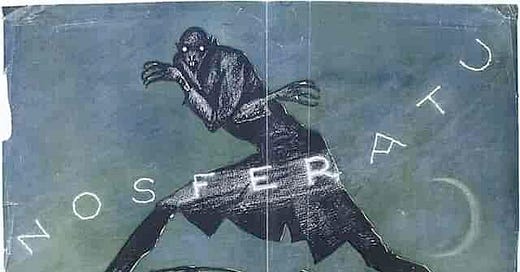Nosferatu (2024): Film Analysis
A vampire film that captures the symbolic nature of vampires as an existential threat, alluring untamed masculinity and profound malevolence found in both nature and humanity. There is a strong tendency amongst readers of vampire fiction - as with any villain - to portray the evil, parasitic nature of the vampire from capitalist parasitism to patriarchal tyranny of a malevolent old land-owning aristocrat. However, the vampire figure has a dual meaning within Robert Eggers' latest incarnation of the silent classic. The first being one of abuse and attraction, the other being the mythological representation of Nosferatu as an amalgation of human fears about naturally occuring malevolence - namely, a plague.
The first apparent motif was the vampire or "monster's" (known as Count Orlok, played by Bill Skarsgard) attraction to Lily-Rose Depp's character, Ellen Hutter, partner of Thomas Hutter, played by Nicholas Hoult. Unlike conventional vampire romance, this story is yet another variation of the beauty and the beast story, of which such themes pre-dates the disney classic. Count Orlok is far more malevolent than a "beastly" male love interest and is seemingly characterised as a sexual/physical abuser of Ellen from a young age, and his return represents the return of that trauma she faced, but also a powerplay by Orlok to remind his victim that he is omnipresent and will always make her suffer - much like a real abuser.
Interestingly, Ellen displays ambivalence towards this "abuser" by seemingly accepting her fate when Orlok enters her room. Her continual "possessions" by Orlok appears to be a comment on Ellen's dissatisfaction with Thomas at one point as she claimed he was "not like him [Orlok]", and that he never got that promotion, can provide material goods or simply be the man "he is". Although its a possession, it's a projection of her unconscious, symbolically, given her proclivity for ambivalence towards Orlok, she seemingly wants the "beast", over the ordinary gentlemen.
Secondly, Count Orlock's gradual emergence from the dark, rural, apocalyptic pastures of translyvania to the urban setting corresponds to the emergence of the plague, carried by rats into the city. The mythological representation of a natural existential threat, in the form of a plague, has long been a conceptualisation of natural threats since biblical times to capture the monstrosity and fear of phenomena that was difficult to comprehend in pre-modern scientific eras.
Albert Camus' seminal text - "the Plague" - comes to mind, in how he stresses the powerlessness of the individual characters to affect their own destinies. Within the context of this film, the mere powerlessness of every character against the threat of the plague amalgamates in the figure of Count Orlok as the pinnacle of fear - death itself. Orlok is also referenced in the Occultist's monologue, played by Willem Dafoe, as the "undead plague carrier", an explicit reference to the symbolic representation of a figure who brings nothing but darkness and death.
More broadly, regarding the natural world's malevolence, the film contains explicit links to the nature of chaos and order, and alchemical understandings of how we perceive the world, which is explained by the Occultist. During his monologue he claimed "we have been blinded by the gaseous light of science. I have wrestled with the devil, as Jacob wrestled with the Angel... If we are to tame darkness we must first face that it exists." The moral point here could be thought of as an insistence of the natural order of things always containing evil, and that it cannot be simply "banished" by science. The idea that technological innovation alone and reliance on understanding the world through that lens is mentioned repeatedly, albeit as a warning, by Frederick Nietzche who warned of the implications of replying on science as a substitute for morality. The balance between lightness and darkness and trying to sow science and mythology together is an alchemical assertion in of itself, which is best explained as the unconscious knowledge ancients had, during the highpoint of alchemy, in understanding that we must mix two distinct elements to produce a desirable outcome. This is pointed out by Jung as an unconscious proclivity in pursuing truth, which clearly the Occultist is attempting to steer his community towards.
More deeply, this harkens back to the story of the Tower of Babel in the bible, which was founded by Nimrod, who is perceived as having "gone against God" in attempting to rectify human needs/desire through technological innovation in disobedience to God. Even today, in the contemporary real world, the absence of recognition of the innate malevolence of the world, as a natural and re-occurring, fundamental condition of life is something to ignore, forget or try to avoid at one's own peril, or at our collective peril. In order to understand malevolence and combat it, it has to be recognised as something opposed to the good, the "light", which within the film, only emerges at the very end when the symbolic virgin is defiled and killed by Orlok, as the sun rises and obliterates him. The sacrifice of herself for the sake of the community is likely a symbolic representation of the most high of sacrifices, which of course, is embodied within Christian culture as Christ's sacrifice on the cross, after having died "for our sins", the Christians act in his path. And within the film, the plague and malevolence of the natural world embodied in Nosferatu subsides, after Ellen sacrificed herself despite the folly and ignorance of the locals, lack of action and complacency towards natural malevolence.




